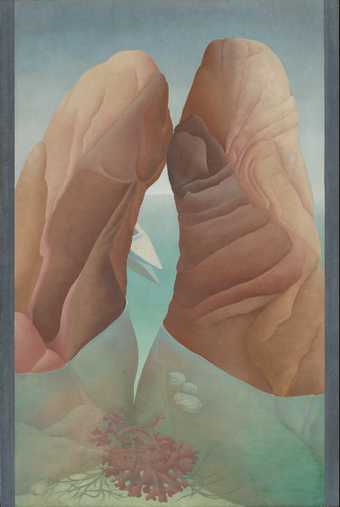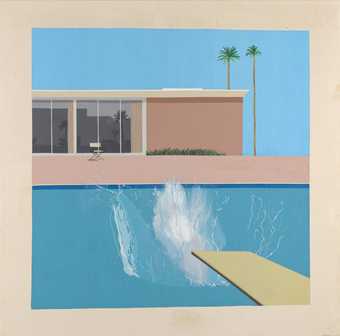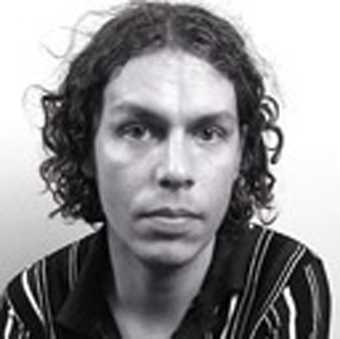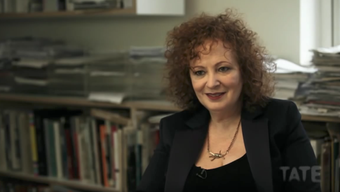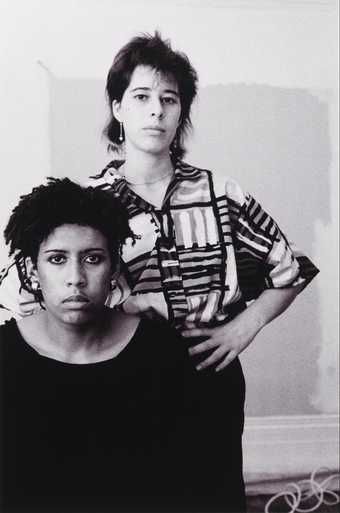
Sunil Gupta
Lisa & Emily, London
(1984, printed 2018)
Tate
Raven Smith: You're listening to Tate Podcast the Art Of with me Raven Smith. I am an author who writes about the absurdity of modern life, and according to some, the funniest guy on Instagram. This is a series telling the human stories behind art. In this episode, we're exploring The Art of Love.
I have some experience with love. I've been in love with my husband for 10 years. We met offline in the halcyon days of my space, when people met in real life and didn't know anything about each other, apart from what was right in front of them.
What is love? Is one of the most searched questions online. As someone who genuinely loves talking about relationships and bad tinder dates, this is a question I've often asked myself, who doesn't want a bit of love in their life? We all do. That shows romance is loved by many and comes in all forms, sculpture, photographs, paintings, films, queer or straight, the art of love is a language that speaks to us all.
Love means different things to different people, from love at first sight to that ex who dumped you via WhatsApp. The various experiences of love have all been expressed through art. In this episode, we'll be exploring some artworks which show infatuation, passion, and even everlasting love.
Speaker 1: Now, I see a heart where genitals are, to me, it shows more than, not just life force, but the wave of the vibration is quite musical.
Speaker 2: The L and O stacked above the V and the E. The O tilted slightly on its side and not the erotic.
Speaker 3: Everything was sex-focused, there was very little about love and relationships.
Speaker 4: It's this very different form of romantic connection. It's about swiping on a certain day, a certain time, and a certain need. You know a lot about them before you turn up on the date potentially.
[laughter]
Raven: What is love? We asked visitors at Tate Modern, what love means to them.
Speaker 5: Love is wonderful. It's the best thing in the world, because it brings people together and it makes them happy.
Speaker 6: Love is glittery.
Speaker 7: Love, [laughs] not being angry that I have to change the stinkiest diarrhea napkin in the middle of the night, and there's only one person I would do that for at present. That's love. [laughs]
Speaker 8: I think love’s just genuinely caring about someone to the point where if they're no longer in your life, then you'll feel a sense of genuine loss.
Speaker 9: Love is a lie. It is something we come up with in our own heads, and people often use against us to manipulate our actions. It's something we allow ourselves to experience because of social belief that you're incomplete without it.
Speaker 10: I want to give you a happy version. [laughter]
Speaker 11: Love is something when you feel connected to someone, and they make you feel complete and you’re pessimist.
[laughter]
Speaker 10: [crosstalk] You're not pessimist.
[music]
Raven: Not quite a lover's tiff, but clearly the meaning of love differs from person to person. One of the most iconic sculptures commemorating love was created by American artist, Robert Indiana, and it's called LOVE (Red/Violet). Now, I have not heard this name before but there is one of the most recognizable pieces of art you'll ever see. If you just Google it, you will be like, "That's the big love sculpture that everyone talks about and looks at." It's one of those pieces of art that has been used everywhere.
Michael Raymond: Hi, my name is Michael Raymond. I'm the Assistant Curator here at Tate Modern. I always start in front of Robert Indiana's love sculpture. It is comprised of four letters, L, O, V, E. The L and O stacked above the V and the E. The O tilted slightly on its side. Lots of people have pondered whether this is not the erotic or that it lines up very well with the V, but also very conveniently, the O tilted on its side allows it to be a perfect square.
I'm sure what you're all wondering is exactly how deep is our love here at Tate, and it is 1.27 meters deep, and I want to say about three meters tall. Robert Indiana himself said, "Love was a marvelous idea, but it was also a terrible mistake." Which I think might applied to some people. It was a work that really became almost too popular for Robert. It overshadowed everything else that he did in his career.
Raven: Indiana's Love was a square which is perfect for Instagram and despite seeming like it might have been designed last week, the history of it is very interesting.
Michael: It's been researched by a lot of people where the inspiration for this piece originally came from. It's been traced as far back as 1955 when Robert Indiana wrote this poem called, When the Word Is Love, he began conceiving this piece, Love, as a print originally in 1964.
It then became a Christmas card for MoMA in 1965, MoMA being the Museum of Modern Art in New York. It completely captured the zeitgeist two years after 1965, of course, was the Summer of Love. You had The Beatles All You Need is Love. It was a term that really encapsulated the idealism of the late '60s and the sexual revolution.
In 1973 it was produced as a postage stamp in the City of Philadelphia in time for Valentine's Day, which sold a whopping 330 million copies. Since then, it's gone on to be reproduced all over the world. There are giant Love sculptures in cities across the world in different languages. It really is probably one of the most iconic sculptures of the late 20th century.
He saw himself as a victim of his own success and the success of Love. It really overshadows almost everything else he did for the rest of his career. He said, and I quote, "What have I learned about love? It's a dangerous commodity fraught with peril."
Raven: These next artists want you to consider how our sense of hearing, particularly music, affects how we fall in love. This relatable artwork is a film by British artists and film making duo, Iain Forsyth and Jane Pollard, it's called, Anyone Else Isn't You. The title comes from a song of the same name. The video explores how our taste in music influences our choice of lovers. Here's a short clip from the video artwork.
Jane Pollard: Once you find someone that you like, it's almost the first question that you asked them is, "What's your music taste? And what does music mean to you emotionally?"
Iain Forsyth: I mean, if you're musical fascist or fan, and that's the same thing. Then there's certain bands that are just a no-no and that person immediately destroyed any chance of ever being with you by liking a certain band.
Raven: Having a different taste in music can make or break a relationship. We've all been there. Elise Bell is an arts writer. She's also one of the founders behind Tabloid Art History.
Elise Bell: In Anyone Else Isn't You, it's kind of this static film portray of 14 young adults. I'd say in their early 20s just discussing the very [unintelligible 00:08:03] but also electrifying moments of romance in their lives that hinge around music.
It goes from someone talking about how integral it is that their future partner likes the Talking Heads to, for example, someone talking about how much they hate the Talking Heads. It's this beautiful, interweaving narrative of what it was like to be a young person falling in love or trying to fall in love in 2005, which, according to the video was lots of house parties, it seems. We don't have that anymore. [laughs]
Raven: No, apps have effectively killed the house party.
Elise: Apps have killed the house party and that's something that I felt was really clear in the film was that firstly, the death of house parties. [laughs] Certainly secondly, this idea of romance and dating being a happening, a moment where you meet someone in a kitchen or a bus stop or on a train and certainly it feels like those moments have been lost in some way with the emergence of dating apps, which I think we're all guilty of. I mean, have you used any of the apps?
Raven: No comment. I met my husband on the night bus so I feel like a fossil of pre-dating times.
Elise: Oh my God, when did you meet him?
Raven: 10 years ago, before we had Uber or any cash really, to be honest.
Elise: Pre-Uber and pre-Tinder so this really is a kind of-- or was it pre-Tinder?
Raven: I think so. It feels like a long time ago that I met him and he climbed aboard the night bus and fall in love.
Elise: You see that's a really beautiful story. It's certainly something that you wish or hope would happen to you. I mean, I met my partner on a dating app. It's this very different form of romantic connection. It's about swiping on a certain day at a certain time in a certain mood and I think this work certainly contrast against that current climate of dating.
Raven: I would also say you probably know someone's music preferences before you turn up on the date now.
Elise: [laughs] You know a lot about them before you turn up on the tape potentially.
[laughter]
Raven: Sometimes too much.
Elise: Sometimes too much. Do not give anyone your Snapchat details from hinge.
Raven: [laughs]
Speaker 12: You watch as he goes through your CD collection because if there's things in there he doesn't know, maybe he's not right for you at all. [laughs]
Raven: Watching the video, you get a snapshot into these people's personal lives almost like they're your friends. They chat about mixtapes, cassettes in a pre-digital age that were sent or received from someone they were dating
Elise: In terms of modern times. I don't remember the last time or even saw a mixtape. Certainly, there's something romantic maybe about making a Spotify playlist for someone, but it doesn't have that same kind of analog craft that a mixtape has or a vinyl has, even a CD that you write on in a little permanent marker, the different tracks on the CD. It's not the same. I think the black and white nature of this film and almost like the fuzziness of the TV bring brings you back to this early 2000s sort of late '90s era of physically putting things on a mixtape.
Raven: When I asked people about love, I was surprised to hear one man say that love didn't exist in his day. He explained that his marriage was an arranged one and there was no room for love. He was visiting Tate Modern with his granddaughter.
Speaker 13: I don't know the definition of love. When I got married there was no love. They were no such thing called love. My father said, "You're going to marry this girl," and that was it. I got married in 1961. In those days, what mom and dad says that's it, you have to listen to them. [laughs] Now, it's all changed. [laughs] Even in India, it has changed now, but in our time, there was no such thing. No such thing as love. It's all that end, everything that end.
Raven: His granddaughter was listening and had a very different take on love.
Speaker 14: That was his experience and what he thinks. I can love him and I respect what he thinks that love is and I have to respect that because I love him. I just think it's about sharing happy experiences and things that you love to do with other people. You can love as many people as you want, but there are only a few people that you truly love.
[music]
Speaker 15: Hey, there are you 16 to 25? What five-pound tickets to take exhibitions, free events, creative opportunities, and special join Tate Collective. Make sure you follow us on Instagram, Facebook, and Twitter too.
[music]
Raven: For me, one of the standout pieces on love is David Hockney's, A Bigger Splash, which is in Tate Britain. Hockney is a British artist and seen as a hugely important contributor to the pop art movement of the 1960s.
In 1964, Hockney visited California for the first time. This inspired him to paint this artwork. In the painting, you can see a blue LA swimming pool and the splash of someone who's just dived in. It's an idealized gay LA lifestyle. It doesn't have to have any male figures or suggestion of who's in the pool, but it's sensual and talk to an intimate love not often seen.
LGBTQ plus love depicted through art has always been there, but sometimes you had to search for it and queer artists have struggled to get their work out to a wider audience. This is true of our next work Indian born artist Sunil Gupta took photographs of queer couples during the 1980s.
Sunil Gupta: It was called Lovers: 10 Years On to commemorate my 10-year relationship, which to my peers at the time seemed like a record. [laughs]
Raven: The series includes over 30 black and white portraits of couples living in the UK. Most of the subjects are shown in affectionate embraces. They were mostly the artist's friends in the queer community. Some photographs even include the couple's pets, others pose in front of works of art in their living rooms or in their kitchens. One of these pieces I discussed with Sunil is called Lisa and Emily.
Sunil: Lisa and Emily happened because Emily was my classmate at the Royal College. I'm a shooter actually, that kind of photographer background, so I would just take a lot of pictures all the time, but now and then I'd stop and do something more formal and I thought, “I'm just going to take these very direct, quite modernist images, they're all short without lighting.” They were simple pictures in a way. These are people I felt I knew and understood. I was passed on from one couple to another couple kind of thing. They knew each other. They would have been a Facebook group if there had been Facebook.
The entire series is composed of homosexual couples, two of them are female and the rest are all male. The gay men were always particular kind who lived in West London and they were social network. They were all white. Mostly, this is the age group that was just beginning to buy their flats. Lisa and Emily were very different because Lisa is black.
Raven: The project was sparked by the end of his own 10-year relationship.
Sunil: I had gone from being 20 to 30. It had been my first very serious, committed relationship. I didn't think that kind of thing was going to happen to me, it took me by surprise a little bit. I thought, “Well, one way to mend myself would be to use the camera,” which I've done now and then over the years is a therapeutic tool almost. Because I think what happens when you break up with somebody is that you have this tremendous loss of control.
When you make pictures you can regain control. I had that feeling anyway and so I thought, “Okay, I'm going to find all kinds of lesbian, gay people who are together and maybe it'll give me clues. Maybe there was something I'd missed.” Because I couldn't figure out how-- It felt like a failure for me to have broken up at that point. My self-confidence was shattered.
Raven: The series of images weren't really appreciated at the time. Sunil found it difficult to show them in the ‘80s.
Sunil: Gay liberation had provided us with the political excuse to be anti-family and pro-sex and promiscuity, so, as a consequence there was no guidelines about settling down or how to engage or carry on a romantic relationship. There was no clear models and this idea we have today of gay marriage was very far away and didn't even occur to anybody that that would be possible or even maybe desirable. We come up with that whole legal, law-changing discussion which was all very focused on decriminalizing sodomy and sex. Everything was sex-focused, so very little about love and relationships.
[music]
Raven: Next on our journey of love is a surrealist painting by the British artist Ithell Colquhoun. Hanging in Tate Britain the painting is called Scylla and it was made in 1938. The title refers to the female sea monster who, according to Greek mythology, fed on passing sailors. It looks like a channel between two cliffs in the sea but take a closer look and the rock formations can also be seen as knees with seaweed in place of pubic hair.
There was also something quite phallic about those two rocks. This was painted at a time when Colquhoun was exploring surrealist ideas such as the double image. The artist said it was inspired by how she saw the body whilst in the bath. As we're walking through Tate Britain, I asked Elise Bell for her first impressions.
Elise: It's certainly quite phallic, isn't it?
Raven: Yes. I first of all saw penises.
Elise: Two penises.
Raven: Two penises but it's actually quite feminine image.
Elise: Yes, certainly, and the curves and the gentle sea touching these cliffs phallic stones.
Raven: I think these are the knees. She's in the bath.
Elise: This is like a Love Island style shot isn't it?
Raven: Yes. [laughs]
Elise: This is getting the thigh gap right in there.
Raven: It's a Love Island thigh gap rendered in oil paint.
Elise: Oil paint and made in 1938.
Raven: Classic. Actually, the first year of Love Island was filmed in '38. [laughs]
Elise: I had no idea. You watch it and you get that vintage sense, don’t you?
Raven: You can tell it's got history.
Elise: It's romance through the ages.
[laughter]
[music]
Raven: Shareefa Energy is a spoken word poet, writer, a member of the South Asian poetry collective, The Yoniverse. How does this painting resonate and speak to her about love? I took Shareefa to see it. I didn't give her any details about it beforehand. I was interested in finding out what she saw and how she felt about it. This is Scylla.
Shareefa Energy: It's very interesting in the sense that there's a lot going on, the painting merges outwards and upwards, as well, that's quite interesting. Like a fossil but not a fossil. It looks like genitals. [laughs]
Raven: A lot of people have talked about how this painting is like legs in the bath, two knees, hotdogs or legs. Do you remember that from the internet?
Shareefa: Yes.
Raven: It’s a bit hotdogs or legs.
Shareefa: Yes. I can see where you're coming from now because you've got the seaweed at the bottom, but she's got spots on her leg.
Raven: Yes.
[laughter]
Raven: Maybe she's got a rash.
Shareefa: Then she's got--
Raven: I surrealist rash.
Shareefa: She still plays with ax but both versions-
Raven: Yes.
Shareefa: -in the mouth.
Raven: Yes, the pieces based on Homer's Odyssey a sea witch or a sea creature called Scylla who basically guards the passage of water between two places.
Shareefa: The more I'm looking at everything is changing, it's quite creepy. It reminds me of I think Cornwall or Devon you've got, it’s kind of like a gateway.
Raven: In the cliff?
Shareefa: Yes.
Raven: I've swum towards that, and my husband and I said we were going to pretend we jump through it because it was quite choppy. We didn't quite go all the way but, yes. In Durdle Door?
Shareefa: Yes, Durdle Door. Yes, that's one.
Raven: It's like Durdle Door.
Shareefa: The more we're unfading it almost I'm more intrigued I feel like getting closer to it.
Raven: Let's do it.
Shareefa: Almost, yes. [laughs]
Raven: My instant impression is this juxtaposition of the feminine and the masculine in a way that I saw penises. The first time I saw it I was like, “It's two dicks.”
Shareefa: Then it almost looks like a hand. A hand holding itself together first but now it looks like an athletic woman.
Raven: Yes, but the boat possibly could be very suggestive.
Shareefa: Yes, toys, just in general.
[laughter]
Raven: Their famous sex toys of Homer's Odyssey.
Shareefa: Yes.
[laughter]
Shareefa: It's like [unintelligible 00:21:45]. There's so much because first it looks like an image on the external but then you look at a bit deeper then everything the angle changes and everything is rotating and it’s quite tricky, to be honest.
Raven: Yes, I think part of the surrealism of it is that it never sits still as one. You're looking at multiple sides of it all the time and they keep morphing.
Shareefa: Yes.
Raven: What do you think the painter wanted to say with this constantly shifting, I want to say reality of the painting. Because I think in a way, you're searching for something that makes sense and it keeps changing.
Shareefa: Now I see a heart on the bottom where genitals are which is like a heart.
Raven: These are what's it called ventricle now without the muscle around the heart.
Shareefa: For me, it just shows more than not just life force but life in its form of movement. I understand that we could look at a picture of someone that might post on Instagram today on their island holiday but at the same time may be reflective of an earlier time, that's just how I see it. I'm Indian so I know a lot of historical basis of life even sexuality and other things they were explored, so I don't know.
[laughter]
Raven: It is flirtation between her and the boat.
Shareefa: I just like the way even the water meeting the legs the way it's vibrating, it shows the wave of the vibration of it, is quite musical. I really like this. I'm actually surprised. When I first looked at it, obviously you see something first and sometimes I go around galleries and I don't have the time to really stand there in front of a painting and really look at it but it’s been quite interesting for me to just really pull it apart.
Raven: Discover it in real-time it's beautiful.
Shareefa: Yes, I really like it.
[music]
Raven: The more I think about it love and art are very similar, they are almost impossible to condense into one soundbite, into one expression. What really stood out for me was just how much we all experience love in unique ways and all see different messages from each piece. I think all good art reflects something of yourself back to you. Art communicates the complexities of love, how you have been loved and how you love.
If you want to discover more artworks which have been inspired by romantic love take a look at Tate Rosenberg by Alex Pilcher called Love. From passion and dating to heartbreak and loss the book explores 500 years of love in art. You've been listening to Tate Podcast the Art Of with me Raven Smith. If you've enjoyed this episode please rate, review and subscribe so that you don't miss out on new episodes.
Join us next time for the Art of Persona where we explore Andy Warhol and the role of persona performance and identity in art. This episode was a Stance Media production for Tate produced by Catherine Menel researched by Deborah Sharindey and executive produced by Crystal Genesis.
[00:25:05] [END OF AUDIO]
What is love? is one of the most searched questions online. In this episode, author, journalist and ‘the funniest guy on Instagram’, Raven Smith explores how the various experiences of love have been expressed through art.
Art that shows romance is loved by many and comes in all forms. From sculpture and photography, to paintings and films – the art of love is a language that speaks to us all.
Hear from assistant curator at Tate, Michael Raymond, poet Shareefa Energy, artist Sunil Gupta and writer Elise Bell as they chat about their thoughts and experience of love in art from Tate's collection.
To discover more artworks which have been inspired by romantic love, take a look at our recent book Love, written by Alex Pilcher. From passion and dating, to heartbreak and loss, the book explores 500 years of love in art.
This episode was a Stance Media production for Tate, produced by Catrin Manel, researched by Deborah Shorinde and executive produced Chrystal Genesis.
Want to listen to more of our podcasts? Subscribe on Acast, Apple Podcasts, Google Podcasts or Spotify.

